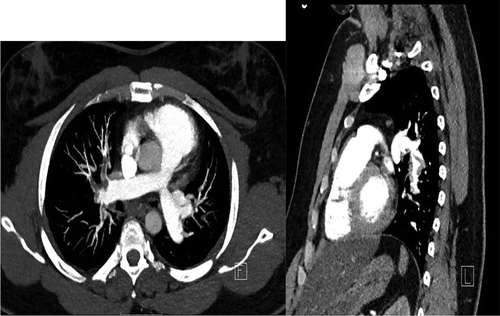ABSTRACT
Pulmonary embolism and deep vein thrombosis are a major cause of hospitalization and cause high mortality. Several risk factors, such as smoking, immobilization, cancer, trauma, OCPs, pregnancy, and surgery, have already been identified. The diagnosis of PE can sometimes rely on high clinical suspicion. We report a case of a young 31-year-old male with no known risk factors, who developed a PE after 5 months of clomiphene therapy.
1. Introduction
The annual incidence of Pulmonary embolism (PE)/Deep Vein thrombosis (DVT) in the USA is estimated at 900,000. The clinical presentation of pulmonary embolism can range from asymptomatic incidental findings to sudden cardiac death. About 15% of sudden cardiac deaths are attributed to PE and 25% of cases of PE present as sudden cardiac death [Citation1]. We present a case of PE in a young individual undergoing fertility treatment with clomiphene, with no known risk factors.
2. Case report
31-year-old African American male with a past medical history of anxiety, depression, obsessive-compulsive disorder, alcohol abuse, and infertility came to the emergency department with the complaint of sudden onset of non-radiating, pleuritic chest pain for over 12 hours. It was not aggravated by exertion or change in position. The pain was associated with left leg cramping for the past few days. There was no associated shortness of breath, fever, chills, nausea, or palpitations. He was physically active with no recent immobilizations, recent travel, or trauma. He quit alcohol a few months ago and denied any drug, or tobacco use. He had no family history of clots/blood disorders, or cancer. His vitals were, heart rate – 120 bpm, temperature – 37.5℃, respiratory rate – 18 bpm, blood pressure – 122/78 mm Hg, and his oxygen saturation was 89% on room air. His cardiopulmonary exam demonstrated bilateral air entry with normal breath sounds, no wheezing or crackles, S1, S2 were normal with no murmurs, rubs, or thrills. His well’s score was 7.5 points (3 points for signs of DVT, 1.5 points for tachycardia, and 3 points for PE equally likely). Initial chest X-ray was unrevealing, and he underwent chest computed tomography angiography that showed several bilateral pulmonary emboli. Subsequent vascular duplex showed non-occlusive deep venous thrombus in the mid and distal thigh within the left femoral vein. He was started on therapeutic enoxaparin dose (1 mg/kg). His home medications included fluoxetine, olanzapine, and naltrexone. He also reported taking clomiphene for the last 6 months as a part of infertility treatment. The case was discussed with the patient’s endocrinology team, and clomiphene was stopped. Tests for Factor V Leiden mutation and prothrombin II mutation were negative; protein C and protein S activity was normal. His urine toxicology screen was negative. The likely cause of the patient’s pulmonary emboli and deep vein thrombosis was attributed to the clomiphene.
3. Discussion
Clomiphene is a selective estrogen receptor modulator that has been used in the treatment of hypogonadism, especially in men of reproductive age, as it does not affect the intra-testicular production of testosterone and hence preserves spermatogenesis. Clomiphene causes an increase in pituitary gonadotropins release, increases the estradiol levels, and cause thrombotic effects. Common side effects of clomiphene include headaches, visual disturbance, hot flushes, and fluid retention. There are a few case reports of clomiphene being associated with central retinal vein occlusion, deep vein thrombosis, and a case report of intracranial venous thrombosis [Citation2]. The duration of therapy leading to thrombosis varies.
In our case, the patient had been started on clomiphene to treat hypogonadism, and after 6 months of therapy, he developed a deep vein thrombosis and pulmonary embolism. Our patient did not have any risk factors for PE, no suspicion of malignancy, and thrombophilia workup was negative. Even in patients with thrombophilia, clot formation is usually triggered by a pro-thrombotic drug (like Oral contraceptives)infections, immobilization, or malignancy. It is important to rule out thrombophilia as these patients are at an increased risk of clot formation and may need a longer duration of anti-coagulation. As our patient’s PE was caused by clomiphene, he was prescribed a 3-month course of anti-coagulation. Even though there are only a limited case reports of thrombosis associated with clomiphene, physicians should be cautious with its use and be mindful of the possibility of pulmonary embolism with clomiphene therapy.
Disclosure statement
No potential conflict of interest was reported.
References
- Samsun Nahar, Pulmonary Embolism- A case report. Available from: https://www.researchgate.net/publication/324705888_Pulmonary_Embolism-A_Case_Report#:~:text=pulmonary%20embolism%20is%20unknown%2C%20but%20it%20is%20estimated,to%20be%20difficult%20primarily%20because%20of%20the%20notorious
- Intracranial venous thrombosis in a man taking clomiphene citrate.

